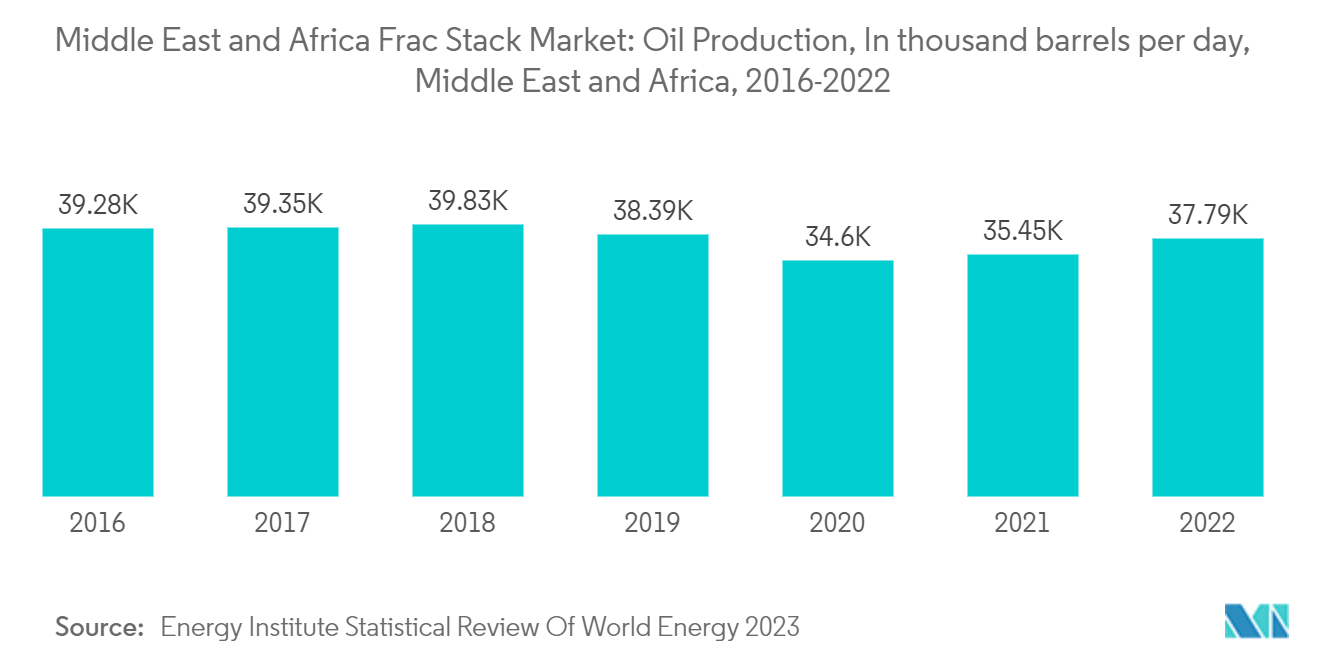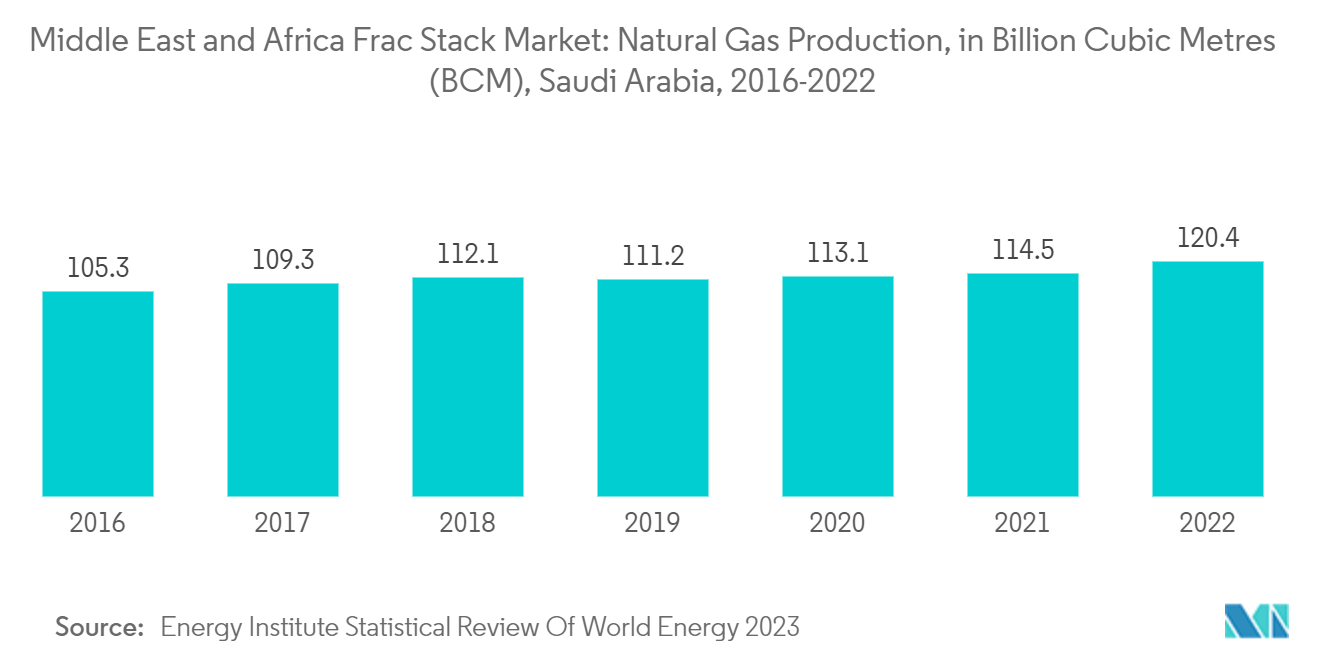Market Trends of Middle-East And Africa Frac Stack Industry
The Onshore Sector is Expected to Dominate the Market
- The dominance of the onshore segment is anticipated in the Middle-East and African frac stack market, driven by several key factors that underscore the industry dynamics. One primary catalyst for this dominance is the considerable onshore oil and gas production activities in the region.
- The Middle East, in particular, hosts extensive onshore reserves, and the prevalent exploration and extraction operations necessitate the use of frac stacks to enhance well productivity. The accessibility and cost-effectiveness associated with onshore projects contribute significantly to the sustained growth of this segment.
- According to the Energy Institute Statistical Review of World Energy 2023, in 2022, the oil production in the region was around 37,786 thousand barrels per day, which was a growth of over 6% compared to 2021. As the fracking activities increase in the region, the production is expected to increase simultaneously.
- Additionally, the logistical advantages offered by onshore operations play a crucial role in their dominance. Onshore sites generally present fewer challenges in terms of transportation and infrastructure compared to offshore counterparts. This logistical ease translates into more efficient deployment of frac stacks, reducing operational complexities and costs. As the oil and gas industry in Middle-East and Africa continues to expand, the practical advantages associated with onshore operations position this segment as a focal point for frac stack utilization.
- Moreover, the technological advancements and innovations in onshore extraction techniques further bolster the dominance of this segment. Continuous improvements in hydraulic fracturing technologies and reservoir management techniques enhance the efficiency of onshore operations, driving the demand for frac stacks. The synergy between evolving extraction methods and frac stack utilization reinforces the onshore segment's leading position in the market.
- As a result, a number of operating companies have shifted their focus to the exploitation of unconventional onshore reserves, such as shale and tight gas reserves, which present lower risk and require a lower capital investment than large offshore projects. During the forecast period, there is expected to be an increase in the demand for frac stacks due to the increased hydraulic fracking of unconventional onshore reserves.
- For instance, in September 2022, TAG Oil Ltd was awarded a petroleum services contract by Badr Petroleum Company ("BPCO") to develop the unconventional Abu Roash "F" reservoir ("ARF") within the Badr Oil Field ("BED-1"), a 107 km2 (26,000 acres) concession located in the Western Desert of Egypt.
- Therefore, as per the points mentioned above, the onshore segment is expected to dominate the market during the forecast period.

Saudi Arabia is Expected to Witness Significant Growth
- The Kingdom's prominent role as a global oil producer positions it as a central hub for oil and gas exploration and production activities. Saudi Arabia's vast onshore reserves necessitate efficient and advanced extraction methods, with frac stacks emerging as crucial components to optimize well performance. The robust onshore oil and gas sector, therefore, contributes significantly to the expected dominance of Saudi Arabia in the frac stack market.
- For instance, according to the Energy Institute Review of World Energy 2023, gas production in Saudi Arabia increased by more than 5.2% between 2021 and 2022. In 2022, gas production was 120.4 bcm compared to 114.5 bcm in 2021, signifying the country's increasing oil and gas sector, which drives the compressor market.
- Furthermore, the strategic initiatives outlined in the Vision 2030 framework by the Saudi Arabian government play a pivotal role. As part of this economic diversification strategy, the focus on enhancing onshore oil and gas operations aligns with the growing demand for frac stacks. Saudi Arabia's commitment to modernizing and optimizing its extraction processes reinforces the notion that the country is poised to dominate the frac stack market in Middle-East and Africa.
- The geographical advantage of Saudi Arabia further enhances its dominance in the frac stack market. The country's central location in the region facilitates cost-effective transportation and logistics, making onshore projects more feasible and attractive for investors. This strategic positioning contributes to Saudi Arabia's ability to efficiently deploy frac stacks in its onshore oil and gas operations, solidifying its position as a frontrunner in the regional market.
- Additionally, Saudi Arabia's focus on technological advancements and innovation in the oil and gas sector aligns with the increasing complexity of onshore extraction methods. As operators seek more efficient and sustainable solutions, the demand for advanced frac stacks rises. The Kingdom's commitment to adopting cutting-edge technologies positions it at the forefront of the evolving frac stack market in the Middle East and Africa.
- In May 2023, Saudi Arabia's oil behemoth, Aramco, is receptive to proposals from refining giant Sinopec Corp and the French oil major TotalEnergies, considering their interest in investing in a portion of the Jafurah shale gas development project valued at approximately USD 10 billion. Both Sinopec and TotalEnergies are engaged in separate discussions regarding potential investments in the Jafurah development situated in Saudi Arabia. Leveraging an innovative fracking method utilizing seawater from the nearby Gulf coast, Saudi Aramco anticipates the Jafurah field to yield around 2 billion cubic feet of gas daily by 2030, with a projected total investment of USD 24 billion.
- The stability and predictability of Saudi Arabia's regulatory environment further support its dominance in the frac stack market. A stable regulatory framework enhances investor confidence and encourages long-term planning for onshore oil and gas projects. This stability is a crucial factor for the sustained growth of the frac stack market, as operators in Saudi Arabia can implement well-structured and reliable deployment strategies.
- Therefore, as per the above-mentioned points, the country is expected to witness significant growth during the forecasted period.


